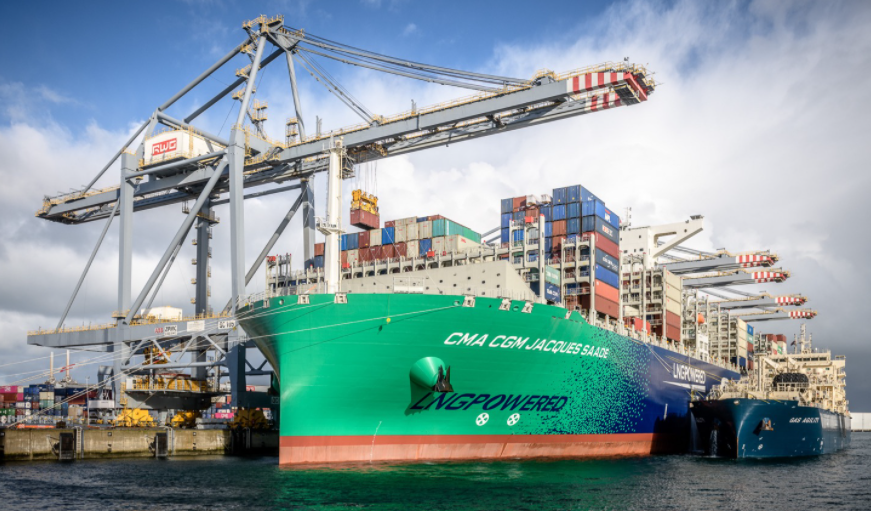
CMA CGM Jacques Saade bunkered by Gas Agility in Rotterdam; Image by CMA CGM
Alternative fuels are gaining traction in the maritime industry amid growing regulatory pressure and currently, they account for 3.5% of the fleet, and 27% of the order book by tonnage, data from Clarksons Research shows.
Liquified natural gas (LNG) is the frontrunner in the race, with 227 (15.1 million GT) confirmed LNG fuel capable newbuilding orders, not including LNG carriers, above the 202 in the trading fleet.
Clarksons said that LNG fuel uptake by segment is lead by tankers (34 in the fleet plus 72 newbuild orders), ferries (50 plus 24), containerships (11 plus 30), offshore (32 plus 19), and cruise ships (7 plus 28).
LNG as a marine fuel has been identified by the industry as the likely bridging fuel and one of the key reasons behind that is the fact that the necessary bunkering infrastructure has been developed considerably over the past few years.
Even though LNG is not the ideal, zero-emission solution, it is virtually sulphur-free and can significantly reduce particulates and NOx emissions.
“LNG’s case as a legitimate ‘stepping stone’ to meet emissions targets is supported by port facility investment: we now record 124 ports with LNG bunkering facilities (up from 114 at the start of the year and forecast at 170 by 2022) and also project that the LNG bunkering fleet will double in size in the next two years,” Steve Gordon, Managing Director at Clarksons Research, said.
At the moment, there are 24 LNG bunkering vessels in the global fleet, according to the shipbroker’s data.
However, issues have been raised about its GHG footprint during its production and life-cycle, with some studies even claiming that it might increase GHG emissions during a 20-year scenario.
Moving forward, LPG as a fuel is gaining good traction within the LPG carrier fleet with one LPG-powered gas carrier in the fleet, 11 pending retrofits led by BW LPG, and 37 newbuild orders.
Posted: about 1 month ago
BW LPG retrofit takes to sea trials
Categories:
Infrastructure
Posted: about 1 month ago
Other alternative fuels:
Biofuel: 23 in the fleet plus 7 newbuildings, excluding recent trials of vessels using biofuel blends Methanol: 12 in the fleet plus 11 on order Ethane:7 in the fleet and 13 on orderHydrogen: 3 newbuilds Battery Hybrid: 141 in the fleet plus 109 on order
Clarksons Research added that the uptake of energy saving technologies is also picking up with the aim of meeting IMO’s short term measures from 2023.
Gordon explained that these solutions will also contribute to the fleet renewal decision-making process, especially around the relatively young, non “eco” cohort of tonnage built in the 2008-12 shipbuilding production peak.
Namely, before the sector develops a completely new generation of zero-emission ships, several other solutions are available to achieve fuel savings, increase energy efficiency, optimize operations,and cut emissions.
The solutions that fall into this category include waste heat recovery systems, exhaust gas economiser, propeller ducts, Flettner rotors, rigid sails, wind kites, air lubrication systems bow enhancement.
Source: Clarksons Research
Another ‘amplifying’ trend to monitor will be further earnings and value “tiering” of fleets, Gordon added.
“Some of this has already started with 24% of the current fleet by tonnage already “eco” electronic main engine and 20% of the fleet already scrubber fitted,” he said.
Source: Clarksons Research
“But as fleet renewal continues and policies evolve there is much more to come. While the shipping industry is just starting an unprecedented investment and fleet renewal program, our aim is to track progress as stakeholders grapple with tricky but important investment choices ahead.”
The post Clarksons: 27% of the order book to run on alternative fuels appeared first on Offshore Energy.
Source: LNG World News
